
Concept explainers
(a)
The location at which a scree has to be placed to display an image.
(a)
Answer to Problem 19P
The location at which a screen has to be placed to display an image is
Explanation of Solution
Given that the focal length of the converging lens is
Write the thin lens formula for the first lens (converging lens)
Here,
Solve equation (I) for
Write the thin lens formula for the second lens.
Here,
Solve equation (III) for
Write the expression for the object distance for the second lens.
Here,
Use equation (II) in (IV).
Conclusion:
Substitute
Substitute
This indicates that the image is virtual, so it cannot be displayed on the screen. On the other hand, a card can be placed in between the two lenses, at
Therefore, the location at which a screen has to be placed to display an image is
(b)
The location at which a scree has to be placed to display an image when the separation of the lenses is
(b)
Answer to Problem 19P
The location at which a screen has to be placed to display an image is
Explanation of Solution
Given that the focal length of the converging lens is
Equation (VI) gives the distance between the diverging lens and its object.
Equation (IV) gives the distance between the diverging lens and its image.
Conclusion:
Substitute
Substitute
This indicates that the image is real, so it can be displayed on the screen. A screen can be placed at
Therefore, the location at which a screen has to be placed to display an image is
Want to see more full solutions like this?
Chapter 24 Solutions
Physics - With Connect Access
 College PhysicsPhysicsISBN:9781305952300Author:Raymond A. Serway, Chris VuillePublisher:Cengage Learning
College PhysicsPhysicsISBN:9781305952300Author:Raymond A. Serway, Chris VuillePublisher:Cengage Learning University Physics (14th Edition)PhysicsISBN:9780133969290Author:Hugh D. Young, Roger A. FreedmanPublisher:PEARSON
University Physics (14th Edition)PhysicsISBN:9780133969290Author:Hugh D. Young, Roger A. FreedmanPublisher:PEARSON Introduction To Quantum MechanicsPhysicsISBN:9781107189638Author:Griffiths, David J., Schroeter, Darrell F.Publisher:Cambridge University Press
Introduction To Quantum MechanicsPhysicsISBN:9781107189638Author:Griffiths, David J., Schroeter, Darrell F.Publisher:Cambridge University Press Physics for Scientists and EngineersPhysicsISBN:9781337553278Author:Raymond A. Serway, John W. JewettPublisher:Cengage Learning
Physics for Scientists and EngineersPhysicsISBN:9781337553278Author:Raymond A. Serway, John W. JewettPublisher:Cengage Learning Lecture- Tutorials for Introductory AstronomyPhysicsISBN:9780321820464Author:Edward E. Prather, Tim P. Slater, Jeff P. Adams, Gina BrissendenPublisher:Addison-Wesley
Lecture- Tutorials for Introductory AstronomyPhysicsISBN:9780321820464Author:Edward E. Prather, Tim P. Slater, Jeff P. Adams, Gina BrissendenPublisher:Addison-Wesley College Physics: A Strategic Approach (4th Editio...PhysicsISBN:9780134609034Author:Randall D. Knight (Professor Emeritus), Brian Jones, Stuart FieldPublisher:PEARSON
College Physics: A Strategic Approach (4th Editio...PhysicsISBN:9780134609034Author:Randall D. Knight (Professor Emeritus), Brian Jones, Stuart FieldPublisher:PEARSON





